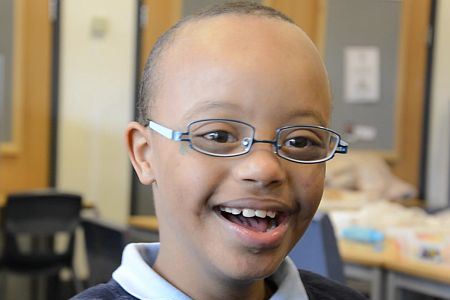Children with autism most likely to miss out on eye care
National sight loss and disability charity SeeAbility has found that three quarters (75 per cent) of children with no history of eye care tested as part of their Children in Focus Campaign were noted to have Autistic Spectrum Disorder (ASD). They are estimating over 33,000 children with ASD in England’s special schools could be missing out on routine eye care.
The alarming statistics come as MPs debated a motion on Thursday 28 April during World Autism Awareness Week, following a bid from Cheryl GIllan MP, Conservative MP for Chesham and Amersham.
The charity has been sight testing children in a number of special schools since 2013 and its second annual report titled ‘28 times more likely’1, named because children with learning disabilities are 28 times more likely to have a serious sight problem. The report also exposes:
- Over half of children tested had a vision problem
- 43 per cent of pupils seen for the first time had no history of eye care
- 85 per cent of those discharged from hospital eye clinics had no follow up community eye care
- 36 per cent of children seen needed glasses
It follows SeeAbility’s 2015 Children in Focus Campaign launch, which revealed nearly four in ten children attending special schools in England have no history of eye care. After an additional year of sight testing behind them, SeeAbility now says a large proportion of that group are children with ASD2.
Although every child in England is entitled to a free NHS sight test to pick up on any problems with vision and help prevent avoidable sight loss, many children with ASD can struggle to access community optical practices or hospital eye clinics where these sight tests are delivered. The environment or waiting time might be too stressful or overwhelming and parents may be worried that their child cannot cope.
With over half of children tested by SeeAbility having a vision problem, their sight testing model targets children at the highest risk of sight problems and brings eye care to the more convenient and familiar place of school. There are added benefits like providing glasses – including specialist frames – sharing strategies to help children get used to the new experience of wearing glasses and helping teachers to understand what a child can see in school.
Nasir has ASD and Down’s Syndrome and attends The Village School in London. Strange places and new people make him feel anxious, which often leads to challenging behaviour. His mum openly admits she cannot take him to a hospital eye clinic or community optical practice, so when SeeAbility is able to be flexible when he is having a bad day and reschedule his sight tests for another week, it offers him routine eye care that he has never been able to access before.
From 2014-2015 there were over 460,0003 missed or cancelled paediatric outpatient eye care appointments. In the SeeAbility sight testing model, if a child is too ill or anxious – both likely reasons for not attending a hospital eye clinic – their appointment is simply rearranged and allocated to another child on the day. The model also stops children and their parents requiring time out of school and work to attend.
SeeAbility is calling on the government and NHS England for a national programme to provide routine eye care for children in special schools across England. Because children with learning disabilities can be reliant on hospitals for more routine eye care or check ups, the charity believes that their model could help ease some of the pressure on the NHS.
“I’m constantly being told by people that they thought someone was already carrying out this service for children with disabilities,” says Lisa Donaldson, Clinical Lead of the Children in Focus Campaign. “The simple fact is, while there are areas of good practice, this is not happening on a national scale. The SeeAbility sight testing model meets a recognised health inequality and reaches children who are unable to access community eye care and their right to a free NHS sight test. We would like to see a national programme that works for the child and builds the importance of vision into their education, giving them greater independence, a better education, and saving the NHS and care services money in the long run.”
You can find out more about Children in Focus at https://www.seeability.org/children-in-focus.
1 The report “28 times more likely” with more detail on the research by SeeAbility can be found at seeability.org/childreninfocus
2 It should be noted that this information about ASD was based on the forms collected from the children prior to the specialist sight test which asked for primary special educational need. The charity explains in the report it is highly likely many of these children will have a mixture of other needs or other diagnoses that would be recorded by their GP or in their Education, Health and Care Plan.
3 This data is calculated from the following written parliamentary answers to questions tabled by Siobhain McDonagh MP 1) Paediatric ophthalmology outpatient appointments parliament.uk/business/publications/written-questions-answers-statements/written-question/Commons/2016-02-22/27616 2) Other paediatric eye care outpatient appointments, excluding “orthotics” which was mistakenly included www.parliament.uk/business/publications/written-questions-answers-statements/written-question/Commons/2016-03-04/29822/
